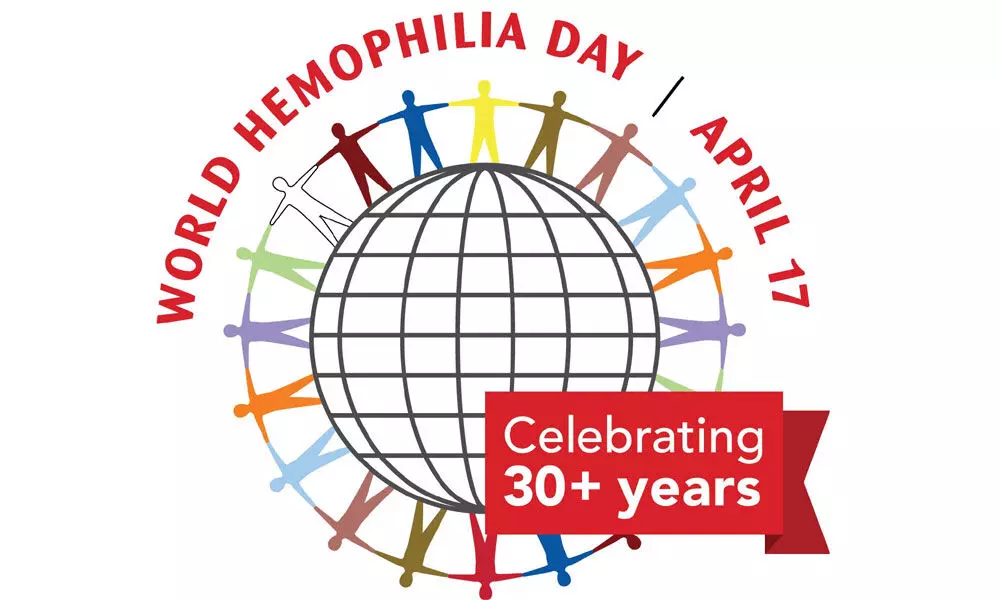Live
- HMPV Outbreaks Spark Global Health Concerns: What You Need to Know
- Gautam Gambhir Faces Criticism Over Tactical Errors in Australia Tour
- CM Revanth Reddy Announces Surprise District Tours Starting January 26
- Telangana's TOMCOM Invites Applications for Driver Jobs in Germany
- Calcutta HC rejects plea by rights body for stall allotment at Kolkata Book Fair
- Bengaluru Beer Prices to Rise by Up to 20% Starting January 20
- My Fans Are Like Disciplined Soldiers: Nandamuri Balakrishna
- Adani Group raises Rs 4,850 crore after selling 13.5 pc stake in Adani Wilmar
- "Jogulamba Gadwal Health Officials Assure Public: No Panic Over HMPV Virus".
- "Charity and Annadanam Program Held on BOSS Hanumanthu Naidu’s Birthday".
Just In

World Hemophilia Day
Nicking your finger with a knife while chopping some tomatoes for a salad is just a nuisance for most of us we utter a choice word or two, rinse the cut, apply a disinfectant and maybe a band-aid, and then proceed to go on with our lives
Nicking your finger with a knife while chopping some tomatoes for a salad is just a nuisance for most of us we utter a choice word or two, rinse the cut, apply a disinfectant and maybe a band-aid, and then proceed to go on with our lives.
The same goes for, say, tripping and falling—most of us will just get up and keep on going, not giving the situation any more thought and barely noticing the bruise that may appear afterward. Unfortunately, there are people whose very lives may be put in danger because of such seemingly minor accidents: hemophiliacs.
Hemophilia affects approximately 400,000 people worldwide, many of whom are not fully aware of their condition or are not getting the treatment they need. Because a relatively small percentage of the world's population suffers from hemophilia, many people are not aware just how serious this condition is and how much more difficult and dangerous it makes the lives of those who have it. And this is where World Hemophilia Day comes in.
Hemophilia was first discovered in the 10th century, when physicians started to take a serious interest in people, especially males, who were bleeding to death after sustaining only minor injuries. At that time, it was called Abulcasis. Unfortunately, due to the limited technology of the day, it was impossible to research the condition properly.
Numerous famous historical figures are thought to have had hemophilia, especially members of the European royal families, and it was often treated with aspirin which thinned the blood of the hemophiliac further, causing the symptoms to worsen.
Then, in 1803, Dr. John Conrad Otto of Philadelphia began to study people he called, "bleeders" more extensively, recognizing it to be a hereditary illness that was most often passed onto males from by their healthy mothers. In 1937, hemophilia was officially divided into two types: A and B. Though no cure for hemophilia has been invented till this day, the sickness can be controlled by administering clotting factors on a regular basis in order to avoid spontaneous bleeding episodes.
World Hemophilia Day was created by the World Federation of Hemophilia in 1989, and the date it's celebrated on, April 17th, was chosen in honour of the founder of the organization's birthday, Frank Schnabel. The day's purpose is to raise awareness about the disease as well as other bleeding disorders and also to raise money for the treatment of those who cannot afford it.
Numerous events are organized every year on World Hemophilia day, filled with educational presentations and other events that promote an awareness of the disease and those who suffer from it. If you are unable to attend, you could consider making a donation to the World Federation of Hemophilia to help support their fight against this debilitating condition, especially in the poorest parts of the world. Another thing you could do is find the World Federation of Hemophilia's Facebook page and proceed to share some of the many infographics they post in order to help your Facebook friends become more informed as well. The same goes for Twitter—follow the World Federation of Hemophilia, and retweet their tweets about this day. It may not seem like much at first glance, but social media has proven itself to be incredibly powerful on many occasions, especially when it comes to getting the word out about an important cause. Even the smallest of gestures can make a world of difference!

© 2025 Hyderabad Media House Limited/The Hans India. All rights reserved. Powered by hocalwire.com







